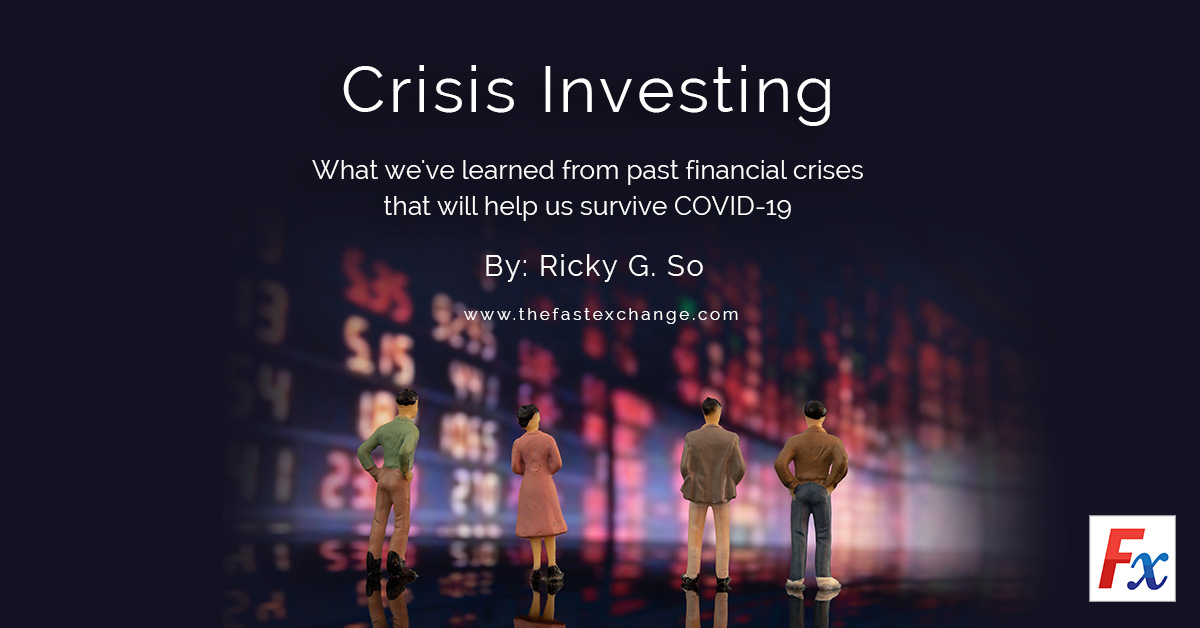
Only in times of crises can you earn multiples, not percentages, of gain.
The first crisis I professionally encountered was the Black Monday of Wall Street in 1987. This somehow was paralleled to the 1929 stock market crash in the United States, which happened on a Monday as well. I was already working as a trader for a commodity futures broker then. This was the year after the 1986 EDSA revolution.
In the next years, I saw Philippine T-bill rates rose to 46% in 1990 following a crash of the Peso from about PhP20 to PhP30 to a US Dollar. In 1993-1994, there was the power crisis. Then in 1997-1998, the Asian Financial crisis. Year 2000 was the Dot Com Bubble, followed by the World Trade attacks in 2001. These were successive years of bearish market moves in Wall Street.
A crisis becomes apparent when the stock market crumbles—because it is likely to hit businesses and negatively affect the economy.
Similarly, in the Philippines, we had the EDSA People Power II in 2001, which was a result of the impeachment trial of former President Joseph Estrada. This led to the 2003 Fiscal Crisis declaration of former President Gloria Macapagal Arroyo (PGMA). Resolved by the passage of new tax laws, the economy was revitalized, only to suffer again in 2008 due to the Global Financial Crisis (GFC) that brought down the global economy.
The GFC reverberated through the Euro zone, that had a big hit in Greece. We saw negative interest rates as early as 2009. It was a growth period since, until the current one, the health crisis, the global pandemic never seen before—COVID-19.
The profile of a crisis
A crisis becomes apparent when the stock market crumbles—because it is likely to hit businesses and negatively affect the economy. Among all the crisis that I’ve mentioned, the duration is from one to two years. Three years or so is a stretch. This is when most people wonder why the crisis is still present and lingering, but the stock market starts to rise in the middle of it.
The stock market is prospective and not reactive. Let us take the 2003 Fiscal Crisis, PGMA then announced the country’s problem. Our debt to GDP ratio was at 75%. It was alarming because the revenues were not enough to meet expenditures, we needed to borrow to pay for our debts and very little went to infrastructure. This was August 2003. Consequently, the stock market tumbled. But in less than a week, it started to rise. In 2008 GFC, the height of the drama was at the last quarter of that year.
It further fell in the first quarter of 2009, the news was still bad. But that was the low and the stock market started to rise since. And many investors, were perplexed by these market reactions. The crisis seemed unresolved, but the market started rising. The reason behind this was that the market has factored in the damaged to be expected. And if resolutions were deliberated, the market can quickly react and rise in expectation of the eventual measures to correct the damage.
How to profit from a crisis?
Believe that this too shall soon pass like the past crises. Research for expert tips on how to buy and put a good reasonable time frame to invest. In the early crises that I saw, I was a mere observer, a watcher. But since 2001, I was able to profit from it—buying at the height of the EDSA People Power II. When people were on the streets, I remember, I was buying equities— with money I can afford to commit for five years or so—almost every other day.
In 2008, I bought a stock that I previously bought the year before. It was already down 75% from my initial price. But I bought some more in December 2008… after five years, sold it at 7x my purchase price. I was trading US stocks as well. I bought Fannie Mae, Ford, and Bank of America shares—at the time it was troublesome for these companies and gained multiples of my purchase price. YES, only in times of crises can you earn multiples, not percentages, of gain. Think about how else it can go wrong buying at the time when is bad for many and to risk your hard-earned money. Invest a Peso, ready to lose half of it but the idea of gaining a Peso, two or three can be worth the risk.
Tips on surviving this COVID-19 crisis
1. Keep a positive outlook
Look back on your glory days, be happy that you and your loved ones are safe and healthy. Be positive enough that this will soon pass like any other crisis in the past.
2. Stay informed
Keep abreast of events, look at potentials, resolutions, solutions, and do your research. Buying a company for 50 centavos that has a book value of P1.80 is not a bad deal. Should the company shut down, the retrieval value is still more than one invested.
3. Commit for 5 years
Make sure that when you invest, you are ready to keep invested for 5 years at least. As expected the crisis will not last that long and the market can recover.
4. Continue to earn
Keep afloat during the crisis. Tighten your belts if need be. Preserve and stretch your financial resources as long as possible and spend only on what is needed.
Invest in yourself
This COVID 19 crisis is quite unique compared to all the crises in the past 30 years. We have never been quarantined like this before. It is both bad and good. We have a lot of time to spend with our loved ones, a lot of time to read those books set aside. Time to reflect and certainly learn something new. Use the internet for a better purpose. Come out of this quarantine a better person. Because when this crisis is over, the world is likely to be different from what we know. To better ourselves in many aspects will never be a waste.
- Ricky G. So
This article is written for FWD Life Phils. https://investment.fwd.com.ph/experts/crisis-investing?fbclid=IwAR3AHpc4GEdAtZHWWnhE38gzWaaTOeXV1vFhU_zOvfKoQUERBzD-iQ3CGN8

One Response
EM Gutib - Tanupan
Wow! Good read and I totally agree, Mr. Ricky! 🙂